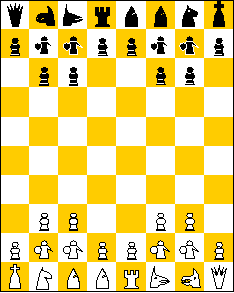Wolf chess
Alfred Pfeiffer send me a copy of an old rule booklet, from 1943, describing this game. The author, dr. Arno von Wilpert describes in this 16page booklet the rules of the game in German, French, Russian and English, and gives a problem and a sample game. He mentions that hundreds of games are played, and that prof. Joseph Boyer (well known for his propagation of chess variants) organised correspondence tournaments.
Rules
The game is played on a checkered board of 10 rows and 8 columns. The knight is missing in the opening setup, but there are also several new pieces to be found in this game, one very strong only appearing when a pawn promotes.
Opening setup
The opening setup is as follows:
 White:
White:
King a1; Nightrider
b1; Bishop c1, d1; Rook
e1; Fox f1; Wolf
g1; Queen h1; Sergeant
b2, c2, f2, g2; Pawn a2, b3, c3, d2, e2, f3,
g3, h2.
Black:
King h10; Nightrider
g10; Bishop f10, e10; Rook
d10; Fox c10; Wolf
b10; Queen a10; Sergeant
b9, c9, f9, g9; Pawn a9, b8, c8, d9, e9, f8,
g8, h9.
Moves of the pieces
The king, queen, rook, and bishop move in the same way as in the normal chess game.
The nightrider, or narr (fool) moves at a single turn one or more steps as a knight, but any of the intermediate fields must be empty and all second and later steps must be made in the same direction as the first one. For instance, when white plays in the opening setup his pawn on c3 (e.g. to c4), then on his second move, white can move its nightrider to f9 (via c3, d5, e7). Note that the nightrider can only take on its last step, as all intermediate fields he passes must be empty (but further than that, each knight move jumps as usual over other pieces.)
The fox has the combined moves of bishop and knight, i.e., it can either move as bishop, or as knight.
The wolf has the combined moves of rook and knight.
The sergeant moves one field forwards, either diagonally or straight, e.g., a white sergeant on d5 attacks and can move to c6, d6, and e6. The sergeant moves as it takes with one exception: the sergeant has, like a pawn the possibility to make a double move on its first turn. In this case, this double move can only be straight, e.g. from b2 to b4. With such a double move, the sergeant may not take. Sergeants never take en-passant, but may be taken en-passant by pawns. When reaching the last rank, a sergeant promotes to a piece, chosen from the following: queen, rook, bishop, knight, wolf, fox, nightrider. (Note that also an underpromotion to a knight is allowed, even when the piece does not appear in the opening setup.)
The pawn moves as a usual pawn. All pawns, also those starting on the third rank has the possibility to make a double move when it has not been moved yet. A pawn that reaches the last rank promotes to any of the pieces the sergeant can promote to (queen, rook, bishop, knight, wolf, fox, nightrider) or to an elephant. In most cases, players will choose the elephant, as this is a very strong piece (a `monster', according to the games inventor).
The elephant has the combined moves of queen and nightrider.
Other rules
Castling is not possible in this game. Other rules are as in orthodox chess.
Note
Von Wilpert suggest to play this game using two different chess sets, e.g., of different size. The larger rook, bishop, knight, queen, pawns can represent the new pieces Wolf, Fox, Nightrider, Elephant and Sergeant.
Written by: Hans Bodlaender. With thanks to Alfred Pfeiffer, for sending a copy of the original Wolf booklet; and for David Paulowich for noting an error.
Last modified: May 14, 1997.
